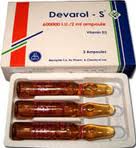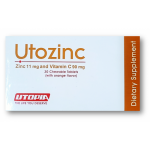
Devarol – S – 200.000 l.U. Ampoule
Generic name:
Cholecalciferol (Vit. D,)
Composition:
Each 2 ml contains:
Cholecalciferol (Vit. D,) 5 mg (equivalent to 200.000 I.U.)
Excipients: Polysorbate 80, propylene glycol.
Pharmaceutical form:
ampoule.
Indications:
Prophylaxis and I or treatment of vitamin D deficiency.
Dosel Mode of administration:
IM route.
The ampoule may be also administrated by oral route.
– Prevention of vitamin 0 deficiency:
It is generally accepted that the prophylaxis of vitamin D deficiency should be systematic, in newboms and infants, in pregnant women (last trimester) and breast feeding women in the late winter and spring, in the elderly SUbjects, possibly in children and adolescents in case of insufficient sun exposure, in the following conditions:
– Non-exposure to sunlight or high skin pigmentation with unbalanced diet (IOW in calcium, vegetarian, .. ) or extended dermatological pathology or granulomatous disease (tuberculosis, leprosy … )
– Subjects under anticonvulsants (barbiturates, phenytoin, primidone)
– S~cts receiving 100g-tj!!l]) corticosteroid
– Digestive pathology (intestinal malabsorption and mucoviscidosis)
– Hepatic insufficiency.
Doses are as follows:
-Infant receiving milk fortified with vitamin D: Y, ampoule (100.000 IU) every 6 months.
– Breastfed infant or not receiving milk fortified with vitamin D and young children up to 5 years old: 1 ampoule (200.000 IU) every 6 months.
– Adolescent: 1 ampoule (200.000 IU) every 6 months during the winter.
– Pregnant woman: Y, ampoule (100.000 IU) in the 6th and 7th month of pregnancy, possibly repeated once after a month, when the last trimester begins in winter or in case of non-exposure to sunlight.
– Elderly subject: Y, ampoule (100.000 IU) every 3 months.
– Child or adult with digestive disorders: Y, to 1 ampoule (100.000 to 200.000 Iuj every 3 months.
– Child or adult under anticonvulsive treatment: Y, to 1 ampoule 100.000 to 200. 000 IU) every 3 months.
-.child or adutt in cases other than thoselisted above: 1 ampoule (200.000 IU) every 6 months. Treatment of vitamin D deficiency (rickets, osteomalacia, neonatal hypocalcemia): 1 ampoule (200.000 IU) possibly repeated once after 1 to 6 months.
Contraindications:
– Hypersensitivity to one of the components, especially to vitamin D.
– Hypercalcemia, hypercalciuria, calcic lithiasis.
Warningsl Precautions for use:
– To avoid overdosage, consider the total doses of vitamin 0 in case of combining multiple treatments containing this vitamin.
– Monitor calciuria and calcemia and stop intakes of vitamin D when calcemia exceeds 105 mgfml (2.62 mmolll) or when calciuria exceeds 4 mglkg/day for adult or 4 – 6 mglkg/day for children.
-In case of high calcium intake, regular monitoring of calciuria is essential.
Pregnancy / Loctation :
Pregnancy :
There is no available teratogenesis study in animals. Clinically, a significant decline seems to exclude the effect of malformation or foetotoxicity of vitamin D. Accordingly, vitamin D may be described during pregnancy if needed.
Lactation:
In case of need, vitamin D may be described during breastfeeding.
Overdosage:
The signs resulting from the administration of excessive doses of vitamin D or its metabolites:
– Clinical: Cephalea, asthenia, anorexia, weight loss, growth stop; nausea, vomiting; polyuria, polydepsia, dehydration; arterial hypertension; calcic lithiasis, tissue calcifications, especially renal and vascular;EDaJ insufficiency·
– Bloioglcal: hypercatciDna, hypercatcemla, yperphosphatemia;hyperphosphaturia.
Recommended behavior: stop the administration of vitamin 0, reduce calcium intakes, and increase the diuresis, plentiful drinks.
Pharmacodynamics:
Vitamin 0 (digestive system and metabolism):The essential role of vitamin 0 is acting on the intestine, for which it increases the ability to absorb calcium and phosphate, and on the skeleton, for which it promotes mineralization (by virtue of its direct
actions on bones information and its indirect actions involving the intestine, parathyroid and bone already mineralized).
Pharmacokinetics:
The vitamin 0 is absorbed in the small intestine in a passive way. then join the general circulation by lymphatic route, incorporated in chylomicrons.
After absorption. it binds to a specific carrier protein and is transported to liver to be converted into 25-hydroxyvitamin 0, which is connected in its turn to the same carrier protein and is transported to kidney where it is transformed to its active form.
1.25 dihydroxyvitamin D.lts essential storage sites are adipose tissues, muscles, but also the blood. The 25-hydroxyvitamin D bound to its carrier protein is the major form of circulating reserve for vitamin D. Its half-life in blood is 15 to 40 days.
The elimination of vitamin 0 and its metabolites is done by feeal route. in un processed form or in hydrosoluble form (calcitroic acid, glucuronide derivatives).
Therapeutic category:
Vitamins.
Legal category:
P.O.M
Package:
Carton box contains one Amber glass ampoule of 2 rnl.
Storage:
Store at a temperature not exceeding 30· C ,away from light.
produced by :
Memphis Company ForPharmaceuticals & Chemicallndusteries
8 Sawah st.- EI-Amirya – Cairo. Egypt

